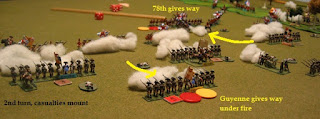The last Fencible game of 2018 was the 1759 battle of the Plains of Abraham , using Keith Flint’s Simple Seven Years
War Rules, a work in progress. I took the role of the French Montcalm, seconded
by Andrew in charge of the Indians and militia on the right flank. Jay took the
part of the British Wolfe. We played slowly, since the rules are new to me and
newer still to Jay and Andrew. Also, I printed the first version of the rules
while Jay had the new version. This caused confusion until the problem was detected.
I must delete the old version from my files. Because I didn’t use the small lamp
with a slight blue tint, the game mat looks much browner in the
photos than it should. I must remember to use that lamp in the future. Ah, the joys of digital cameras.
My final excuse: since the scenario is a work in progress, I
decided to do exactly what Montcalm did and attack the British promptly, to see
if I got the same result.
The left shows my unimpressive representation of the stunning
escarpment along the Saint Laurence River. The wooded areas on the right
represent the gentle downhill from the Plains.
All non-brigaded units were treated as out of command,
needing 4+ on a die roll to advance towards the enemy (or their side of the
table). This cooled the flanks down. We got the initiative and made the British
move first. They stood. We advanced and then fired first, not that much of an
advantage during the first exchange of shots. Markers show the number of hits
each unit has taken.
On the next two turns the British gained the initiative and
made us move first, so they could fire first. Once units were close to being weakened, this
hurt us. Red markers show weakened units, yellow markers show units with bad morale.
Each marker counts as half a unit routed towards that army’s breakpoint. The
French breakpoint was 6, the British 7. Hmm, I did fuzzy math. They should both be 7. Next time.
After the second turn we broke for dinner, accompanied by
the fine wine Andrew had brought. Jay brought a bottle too, but that will wait
for next time.
The third turn saw the French front line savaged by British
musket fire. We also realized that we had been making some mistakes with the
new version of the rules and began applying disorder hits for seeing friends in bad morale. The French line would have been in even worse shape if we had done
this from the start.
Also, the inferior morale rating on most French regulars
(they had lots of drafted militia) made it harder to rally them.
Andrew's skirmishers caused some damage to the redcoats on our right.
It was for naught as French morale collapsed at the end of
the 3rd turn, with two battalions routed, 4 weakened and with bad morale.
Only the weakened Bearn
I was pleased that following Montcalm’s tactics had given
the same result, with the exception that no officers were hit. In the actual
battle all three high ranking French officers were killed, Wolfe died and one
of his three brigadiers was badly wounded.
We played three turns in about 90 minutes. I attribute the
slow speed to using a new version of new rules, the foul up about which version
we were using and the effect of wine on post dinner play. Everyone liked the
game. This most European of the French and Indian War battles was quite a treat
for the eyes. We should play some actual Seven Years War battles too, since we
also have Prussians, Russians, Austrians and some Bavarians.
The scenario right now heavily favors the British, which
seems right. They did stomp the French. To balance the scenario perhaps Bougainville ’s force (1 regular, 1 inferior light cavalry
and 3 militia) arriving on turn 4 or 5 behind the British should be included.
Counting them towards the French breakpoint would increase the breakpoint to 9. This might well be too much. I hope to tinker with this, although some
games with our usual Bloody Big Battles beckons too. I recently received a
scenario for the 1808 battle of Bailen. So many battles, such little time.



















